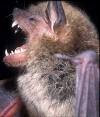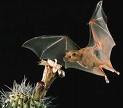A Zoologist will refer to a bat as a "chiroptera" which literally means "hand-wing." If you view their skeleton you will notice that the wing has the skeletal structure of a hand, the difference being , the fingers are elongated. The bat will use these fingers to hold their food. Now a bat is split into two groups called either Megachiroptera or Microchiroptera, which just means large bat or small bat. The largest bats will have a wingspan around six (6) feet. These are fruit bats. The smallest has a body length of about one (1) inch and weight about as much as a penny. The bat is a mammal and the longest known lifespan of a bat in the wild is approximately 30 years for the little brown bat.
Now as for me, I am not a scientist, teacher or professor. I am just an ordinary person who has done some reading on bats and found them to be very fascinating and not at all what I thought. Because they are not what I expected, I thought I would write a little bit about them and at the same time dispel the rumors and myths associated with the bat.
There are almost a thousand (1000) species of bats with each having its own unique characteristics, features, sizes and foods, much like any other mammal. The bat is the only mammal that is capable of true flight. About 70% of the bats in the world eat insects. Some of the microbats can eat about 300 insects an hour and some can eat about 1000 insects an hour. Think about the advantages of having some bats around when you are having a BBQ and the moths and mosquitoes are out. Better than spraying a bunch of insecticides around that stink and very seldom work for long.
According to some research done by "Bat Conservation International" bat habitats are steadily declining because of man. They are doing active research on man-made bat houses and are having some very good results. One of the results they had from their research was that in central Texas they found that the bats in that area eat approximately two million pounds of insects a night. That is 2,000,000 pounds of insects each night. That is an enormous amount of insects eaten that definitely help the farmers in that area.
Most people are afraid of bats or have an active dislike of them. All the vampire movies around perpetuate this fear also. There are actually only three (3) "vampire bats" around and they are in South America. These bats do not suck the blood out of their victim, that only happens in the movies. Their usual food source are large animals such as horses, cattle or pigs. What they do is slit the skin with their sharp nails or razor sharp teeth and lap up the blood. A bat will drink approximately one ounce of blood a night. Scientist have found that these bats have a blood thinning agent in their saliva and they are studying this agent to be used in treating humans. Another fear that people have is that all bats are carriers of rabies. A study by the University of Florida has shown that less than ½ of 1% of all bats have rabies. It is more likely that a person will be bitten by a dog or cat that is not vaccinated. Now if a bat is found on the ground, common sense tells you to leave it alone. Bats are not normally found on the ground, so it has probably been injured or is sick. Again, leave it alone. Another story that has been heard is that a bat will gets caught in somebody's hair. A bat, using its echolocation can find a little gnat in the air and grab it for food. Because of its ability to "see" with its echolocation it probably would have no problem missing someone's hair. Now the big fruit bats, sometimes called 'flying foxes" and a couple of other bats do not use echolocation. However these are all in the jungles and tropical regions of the world. Anyone in these areas should at least be aware of what is in these places. Another reason for the dislike of bats is that in the olden days bats were thought to be able to communicate with the spirits. This and the fact that bats are night creatures, is why they are used on Halloween and the fact is that some people still believe in the old stories.
Bats help us in many way that most are not even aware of. There are many species that can eat thousands of mosquitoes and crop destroying insects in one evening. Others pollinate many fruits and nuts that we enjoy, such as the vanilla beans, peaches, bananas, avocados, dates, figs, mangoes, cloves, cashews and agave. They also eat the insects that destroy the crops and plants. The guana or bat droppings are some of the richest manures in the world.
Bats account for approximately 25% of the mammals and live on all continents except Antarctica and a few remote islands. Like bears, bats will either migrate to warmer areas or hibernate for the winter. These bats can be helped by man putting up bat houses. They are very picky about their homes. They must roost high enough to avoid predators, the right temperatures to stay warm but not too hot and have food and water nearby.
Subscribe to:
Post Comments (Atom)





No comments:
Post a Comment